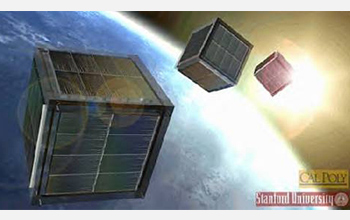|

Press Release 08-168
National Science Foundation Awards Grant to Build "CubeSats"

Small, cube-shaped satellites to benefit space weather research
October 1, 2008
A new series of CubeSats, small satellites in the shapes of cubes, will soon take to the skies. Using the CubeSats, scientists will conduct space weather research impossible with other instruments. The National Science Foundation (NSF) has awarded a grant to SRI International, an independent non-profit research and development organization based in Menlo Park, Calif., to carry out the first space weather CubeSat mission. CubeSats are tiny satellites with dimensions of 10×10×10 centimeters, weighing about 1 kilogram, and typically using commercial off-the-shelf electronics components. Developed through joint efforts, California Polytechnic State University and Stanford University introduced CubeSats to academia as a way for universities throughout the world to enter the realm of space science and exploration. According to atmospheric scientists, CubeSats have the potential to be excellent platforms for technology development and small science missions, and promote student involvement in design, fabrication and flight missions. "One of the goals is to help train future space scientists and aerospace engineers," said Therese Moretto Jorgensen, program director in NSF's Division of Atmospheric Sciences. "CubeSats will also help answer questions in space weather such as the cause of disturbances in the ionosphere, and the rise and decay of the Earth's radiation belts during geomagnetic storms." NSF's interest in CubeSats stems from a recommendation in a 2006 report--Report of the Assessment Committee for the National Space Weather Program--to increase the pace of space weather research. According to the report, agencies involved in space weather should use micro-satellites with miniaturized sensors to provide cost-effective science and operational data sources. In response, NSF created a new program to support CubeSat science missions. The first mission under the new program is a collaborative CubeSat project between physicist Hasan Bahcivan at SRI International and aerospace engineer James Cutler of the University of Michigan at Ann Arbor. The mission, called Radio Aurora Explorer (RAX), will be a single triple-cube satellite, approximately the size of a half-gallon milk carton and weighing about three kilograms. "With signals from powerful transmitters on the ground, which are then received in space, researchers will make unique measurements of small-scale structures in the ionosphere that can adversely impact communication and navigation signals," said Jorgensen. "This project provides a cost-effective way of supporting space weather and atmospheric research," said Bahcivan. "It will also provide excellent training opportunities for students who hope to become future engineers or scientists. " "We have a multidisciplinary, cross-departmental team working on the project, which includes several engineers and a large number of undergraduate and graduate students," said Cutler. The first launch opportunity for the NSF satellite program will be via the Department of Defense Space Test Program, and is scheduled for December, 2009, aboard a Minotaur-4 vehicle to be launched in Kodiak, Alaska. Launch support for the mission will be provided by NASA Goddard Space Flight Center's Wallops Flight Facility in Virginia.
-NSF-

Media Contacts
Cheryl Dybas, NSF (703) 292-7734 cdybas@nsf.gov

The National Science Foundation (NSF) is an independent federal agency that
supports fundamental research and education across all fields of science and
engineering, with an annual budget of $6.06 billion. NSF funds reach all 50
states through grants to over 1,900 universities and institutions. Each year,
NSF receives about 45,000 competitive requests for funding, and makes over
11,500 new funding awards. NSF also awards over $400 million in
professional and service contracts yearly.
 Get News Updates by Email Get News Updates by Email
Useful NSF Web Sites:
NSF Home Page: http://www.nsf.gov
NSF News: http://www.nsf.gov/news/
For the News Media: http://www.nsf.gov/news/newsroom.jsp
Science and Engineering Statistics: http://www.nsf.gov/statistics/
Awards Searches: http://www.nsf.gov/awardsearch/
| 

